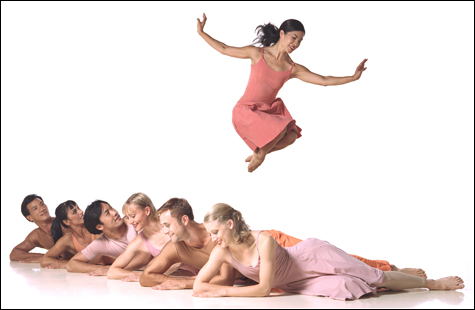
ESPLANADE: Taylor 1975 piece has evolved into a bouncy, almost slapstick company rout. |
In an extended program bio, choreographer Paul Taylor brags that he’s violated just about every taboo in American culture over his 50-plus years of creative work and he’s not through yet. This is fortunate. Many artists talk a good game of dissent, but Taylor is one of the few real resisters around these days. His strategy has always been to stitch a lining of barbed wire into a comfy cloak of dancing.
Lines of Loss, the most recent Taylor work shown at the Schubert Theatre last weekend (in an appearance sponsored by the Celebrity Series of Boston), is a celebration of things we’d rather brood about privately. Taylor proposes a paradox: the symptoms of our pain, sorrow, and anxiety could be prompted by much more harmonious patterns. Cruelty is a step away from playfulness, companionship breeds discord. An ensemble of 11 dancers produces a succession of soloists and duos who rage and lament accompanied by unrelated selections of music ranging from the 14th-century French composer Guillaume de Machaut to the contemporary mystics Arvo Pärt and Alfred Schnittke.

The dancers enter in a procession, dressed in white, with hands clasped close to the body like monks in prayer. Sometime during Lisa Viola’s dance built on exaggerated gestures of sorrow, they form a ring around her. This circle motif, with ingenious variations, encloses other individual outbursts later on. Each recurrence extends the ways in which order can counterpoint the chaos of emotions.
Julie Tice and Michelle Fleet seem like friends who disagree, but once surrounded by four men, they see they’re both caught in a trap. They push against the men’s locked arms to escape, but they’re thrown into the center again. The men pin them down, one by one, and drag them away with their outstretched legs twisted grotesquely.
Michael Trusnovec walks stiffly, leaning on an invisible cane, his body slowly collapsing from the center. He sinks to the ground, curls up on his side. He seems to dream of running. Startled awake, he gets up and makes his way off, still crippled.
Pairs of friends and lovers stroll through the space at one point, at ease with each other. But when Richard Chen See and James Samson are left alone, they seem to grow self-conscious. They dance a duet that veers between desire and repulsion. Later, Viola and Trusnovec find themselves at cross-purposes, in a duet of missed timings and connections.
The piece ends with another procession. This time all the dancers wear blood-red robes, and they ceremoniously lie down, resting against one another in a long diagonal line, acknowledging death at last.
Taylor’s program opened and closed with the vintage classical pieces Aureole (1962) and Esplanade (1975). These dances aren’t classical as in classical ballet. In the deeper sense of the word, they’re formal constructions that explore the delightful and expressive ways a given dance language can be deployed.
Aureole is a pure-dance piece for three women and two men whose spirits, as well as their dancing, seem infected by Handel’s music (selections from his concerti grossi and Jephtha). They don’t take on any Baroque fussiness, but amid their running, spinning, jumping turbulence there’s a sense of sweetness, even modesty. They collect themselves at the ends and beginnings of numbers, with hands neatly spread along parallel thighs. The principal couple (Annmaria Mazzini and Orion Duckstein in Friday night’s performance) embrace tenderly, disregarding the audience, as they wait for their music to begin. The other man (Richard Chen See) flirts mildly with the women but barely touches them, and he waits till they’re gone to let loose explosions of eccentric jumping.
Forty-five years after it was made, Aureole is still surprising. I was noticing Taylor’s fine sense of design in the sculptural curving torso and arm shapes, and the musical way he sets accelerations, decelerations, double time, triplets, and suspensions against Handel’s reassuringly regular meters. The dance never looks balletic to me, but it often turns balleticism upside down, with sleek arms that crumple into sudden zigzags, jumps that grow heavier and deeper instead of higher, and grave, internally focused balances.
Esplanade, to Bach violin concertos, is also a pure-dance composition, in which the simplest steps and gestures gradually build into expressive suggestion and virtuosic dancing. Esplanade has evolved since its creation into a bouncy, almost slapstick company rout. The dramatic and storytelling possibilities are there from the outset, so there’s not much mystery left to the transformation.
In the slow second movement, people stand still and look at one another, extend their hands without touching, gather in momentary clusters. The dancers do this with high drama now, instead of cryptic impassivity. In big numbers, they continually flash encouragement to one another, signaling to the audience that they’re a happily coordinated group of daredevils.
The dance works up to a manic orchestrated chase, in which the dancers fall and scramble up, slide and tumble away, sprint into cannonball lifts. Taylor seems to have added even more potential collisions and noisy running-skid-falls to the choreography. The dancers grin through it all, and the audience screams.